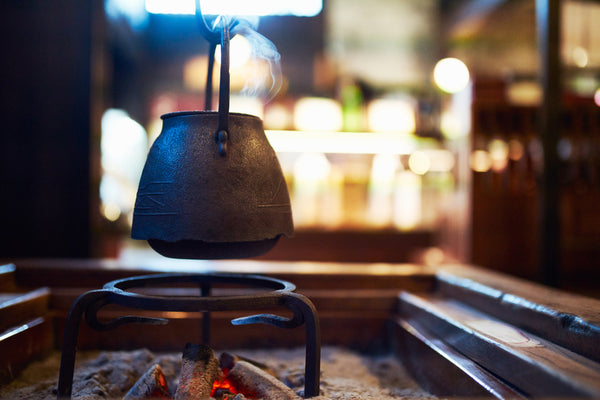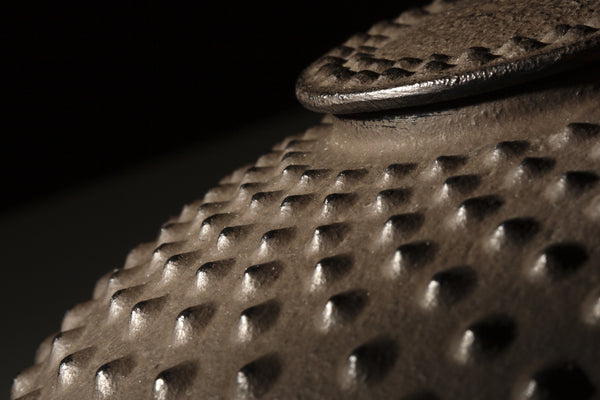Today, we turn our eyes to the East, specifically to Japan, to uncover the secrets behind a staple in the Japanese art of making tea: the Tetsubin.
The Tetsubin, Japan's traditional cast iron kettle, is a cornerstone of the Japanese tea making ritual. Renowned for its robust construction and its role in improving water quality for tea, the Tetsubin is an undeniable part of Japan's tea culture. With roots stretching back through centuries, this essential kettle has transcended its humble beginnings to become a celebrated piece of functional art. In this blogpost, we'll go through the history and origins of the Tetsubin. We'll explore the craftsmanship behind its creation, which has largely remained unchanged for centuries. We will also offer insights into how best to use and care for your Tetsubin, ensuring that it remains a treasured – and functional – part of your tea ritual. Embark with us as we explore the legacy of the Tetsubin and its significance in the art of making tea.
Tetsubin – Japan's cast iron kettle
Tetsubin is a Japanese cast iron kettle with a handle, lid and spout. It is used to boil water during the tea-making process. Its name, Tetsubin (铁瓶), literally translates as "iron jar" or "iron flask". Its size can vary from small (half a liter) to big (several liters). In the past, tea makers used a special type of brasier with charcoal to place the Tetsubin and boil the water. Nowadays, apart from a brasier, you can use any type of heating, including gas, induction, or electric stove, to place your Tetsubin on and boil your water.
Cast iron is believed to improve the water's taste, making the tea sweeter and rounder, enhancing the delicate flavors of Japanese (and not only) teas. Today, we know that when leeching iron in the water, the iron ions bind to the residual chlorine, eliminating the bleachy smell that goes with it. The result is a softer, sweet-tasting water for your tea. People who regularly use tap water to brew their tea will most likely notice a significant improvement in water and tea taste when using a Tetsubin cast iron kettle. Additionally, the iron content from the kettle can offer health benefits, adding minerals to the water. The Tetsubin represents a blend of utility and tradition, enriching both the tea experience and the water it boils.

* a place for family reunion inside an old house with Irori (traidtional Japanese hearth) and Tetsubin
The History of Tetsubin
The exact origins of the Tetsubin remain unclear, yet there's evidence it was closely tied to the rise of sencha tea drinking in Japan. Sencha was introduced from China around the mid-17th century. It involved steeping tea leaves in an informal way as a stark contrast to the formal Chanoyu (茶の湯) ceremonies favored by the elite. Adopting Sencha became a form of cultural protest among the literati, symbolizing a shift away from the strict formalities of the ruling class and the intricate ceremonies using Matcha powder.
By the 18th century, Sencha drinking had evolved into a casual way to enjoy tea among friends and family. With Chinese teaware being both scarce and expensive, the demand for a more accessible, uniquely Japanese teapot led to the creation of the Tetsubin. Historical accounts suggest that Tetsubin was not an entirely new invention but an adaptation of existing vessels. Among various types of Japanese kettles, the Tedorigama (手取釜) and the Yakkan (薬缶 or 藥罐) are most often quoted as the predecessors of the Tetsubin.
As Sencha's popularity grew, so did the artistry in the Tetsubin production. What started as simple iron kettles were transformed into intricately designed art objects by the 19th century, reflecting the craftsmanship and creativity of their makers. This transition marked Tetsubin's journey from a functional item to a symbol of Japanese aesthetic and cultural identity.
Tohoku: The Heartland of Tetsubin Production
The Tohoku region is renowned for its Tetsubin and Tetsu Kyusu production, transitioning from its historical role in weapon making to iron casting for tea culture under the encouragement of local daimyo. This area, rich in iron and wood resources, became a hub for skilled iron casters. The main cities for cast iron ware are Morioka and Mizusawa in Iwate prefecture and Yamagata in Yamagata prefecture. Morioka specializes in high-quality teaware, while Mizusawa focuses on everyday kitchen items. Yamagata's production offers a more straightforward design but maintains high quality. This diversity showcases Tohoku's significant role in Tetsubin production.
Nambu Tetsubin
Tea has a special place in Japan's culture and identity, so it is no wonder there are many types of teapots and kettles. One stands out, though – the Nambu Ironware is arguably the best teaware for preparing and serving Japanese tea.
Nambu Ironware (Nambu Tekki – 南部鉄器) is a traditional craft for making ironware that originates more than 900 years ago to the Heian period (794-1185) in Japan. It started when the then-ruler of Northern Japan had the best foundrymen and casters gather near the town of Hiraizumi, in modern days Iwate prefecture, to construct an elaborate Buddhist complex including a temple, pagodas and gardens. They started to produce Buddhist objects for the religious settlement there. That marked the beginning of the iron craftsmanship tradition in the region. Four hundred years ago, a local feudal lord patronaged the Nambu craftsmanship by having a tea kettle caster from the Koizumi family move near the lord's castle in Nambu and start the production of tea-cast iron kettles. The Tetsubin kettles produced in Nambu were used as gifts to the emperor. Meanwhile, the Koizumi family passed the crafting techniques from father to son. In 1959, the products of Morioka and Mizusawa towns were unified to establish the Nambu Ironware brand, which continues to this day.
The companies that produce authentic Nambu ironware have established themselves as skilled craftsmen and keepers of a national intangible cultural skill, with the vital task of passing down its legacy through time and to future generations. One of those companies is Oitomi – a family company of seven generations that we at Path of Cha are proud to represent. It was founded in 1848 by the first generation representative Oikawa Rigenta in Hada village in the prefecture of Iwate. The fifth generation of the family company was among the few who got a special exemption to continue production during times of war and the first one to export their production to the US as early as 1954. The company had the honor of receiving a personal visit from the then-crown prince (currently Emperor Emeritus) and Princess Michiko. Their production features designs that pass down ancient techniques from their predecessors and were honored with numerous awards from local and national societies.
The making of a Tetsubin
The production of Tetsubin begins with pouring molten iron into molds. These molds can be made of clay for artisanal, high-quality Tetsubin, or sand for mass production. Clay molds are generally preferred for their contribution to the kettle's artisanal quality.
According to the traditional technique, the inside of the pot is baked at a high temperature (about 800°C/1472°F). This leads to the formation of a thin, light-gray oxidized film. It plays two major roles: protecting the interior against rusting and releasing a moderate amount of iron into the brewed water.
After the initial shaping, the Tetsubin's pattern is stamped on its surface, with its quality depending largely on the iron caster's craftsmanship. There are three major traditional patterns. The most popular is the Arare (dotted pattern). Arare means hail or hailstones in Japanese, and that's what this pattern visually reminds us of. The sharpness of the Arare pattern also depends on how many times a mold is reused.

Other patterns include the Hada, known for its rough and irregular texture reminiscent of skin. It has symbolic motifs from Japanese culture, like birds, flowers, or landscapes. This careful and skilled production process gives the Tetsubin its distinguished appearance and quality.
Understanding Tetsubin vs. Tetsu Kyusu
A lot of people mistake Tetsubin and Tetsukyusu. Although they look alike, both serve different purposes. Tetsukyusu is specifically designed for brewing tea. It features an enamel glaze inside and usually includes a removable strainer for convenience. The presence of enamel coating means you can't use it to boil water, as the high heat would damage the coating irreversibly.
On the other hand, a Tetsubin's main purpose is boiling water, not tea. Its uncoated interior makes it unsuitable for direct tea brewing. Identifying between the two is simple: if the inside is enamel-glazed, with or without a strainer, it's a Tetsukyusu. An uncoated interior with a grayish thin film means it's a Tetsubin.
With the rise of cast iron teapots in international and online markets, discerning tea enthusiasts should prioritize craftsmanship and quality, noting that authentic pieces come exclusively from Japan.
Please watch a video on how a Japanese cast-iron kettles (Tetsubin) are made
That's it for today. In our next blogpost we'll share with you a ste-by-step guide on how to use your tetsubin. We'll also shed some light on how to best take care of it, and aswer some of the common questions that may arise in the process.